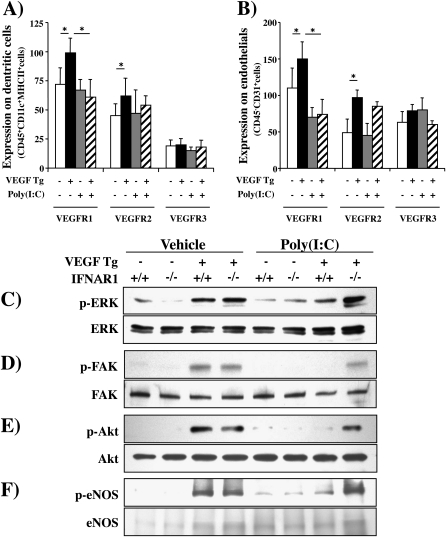Figure 10.
Polyinosinic:polycytidylic acid [poly(I:C)] regulation of vascular endothelial growth factor (VEGF) receptor expression and signaling. In (A) and (B) cell preparations were obtained from transgene-negative (Tg−) and transgene-positive (Tg+) mice that had been randomized to receive poly(I:C) or vehicle [poly(I:C)−] according to the pretreatment−2-week protocol. Fluorescence-activated cell-sorting (FACS) analysis was used to define the levels of VEGF receptor type 1 (VEGFR1), VEGFR2, and VEGFR3 expression on (A) dendritic cells and (B) endothelial cells. In (C–F), wild-type (VEGF Tg−) and transgenic (VEGF Tg+) mice were treated with poly(I:C) (30 μg) or vehicle, transgene activation was accomplished with doxycycline (dox) 24 hours later, and poly(I:C) or vehicle and dox were continued for 2 weeks. The lungs were then harvested and immunoblotting against total and phosphorylated (p) signaling moieties was undertaken as noted. The effects of poly(I:C) and on vehicle on (C) ERK, (D) focal adhesion kinase (FAK), (E) Akt, and (F) endothelial nitric oxide synthase (eNOS) are noted. Comparisons are made of mice that are sufficient (+/+) and deficient (−/−) in IFN α/β receptor chain 1 (IFNAR1). Each blot is representative of a minimum of three similar experiments.

